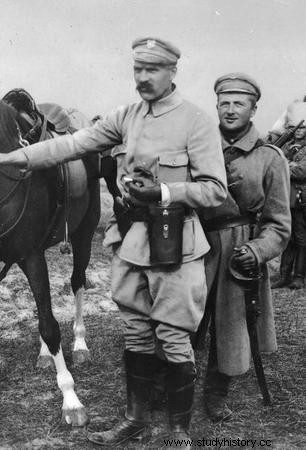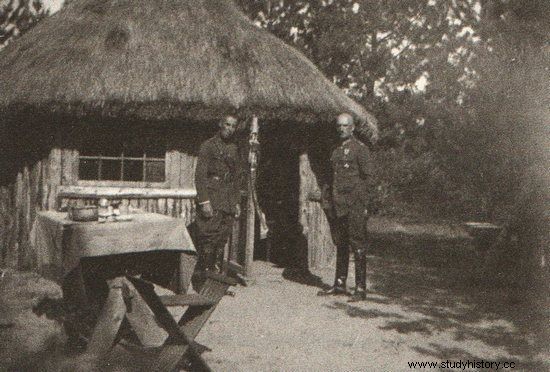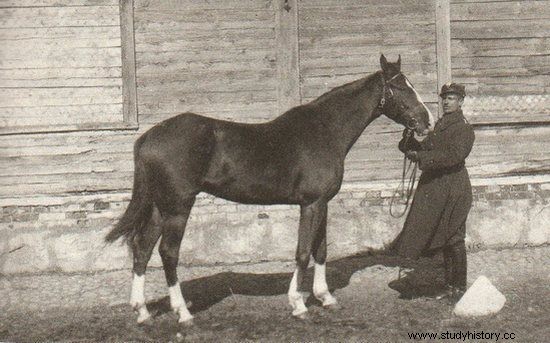strong> Immediately after the so-called "liberation" in 1944-1945, the new authorities targeted the entire tradition of the Polish army to date. Home Army soldiers, pre-war officers, but also ... God of spirit owed the ordinan
The new official propaganda criticized "your army" from the top. Under this peculiar name, the current Polish army was supposed to be concealed, allegedly composed of noble lads, ineffective lords and self-righteous, drunk officers straight from the Legions. In a word - not real soldiers, but a jumble of relics of the "class system" that led Poland to the September defeat in 1939.

Even in the times of the Polish Legions, officers had an orderly. In the photo, Brigadier Józef Piłsudski and his orderly Szymkiewicz
One of the key "evidence" confirming the "lordship" character of the pre-war Polish Army was the fact that each Polish Army officer, without exception, had a personal orderly. But was the swarm of orderlies a manifestation of lordship, or was it just ... simple necessity?
Without an orderly and a cool person, no move
This question was asked in the book "Oficerowie i gentelmeni", Piotr Jaźwiński. As we read in the pages of his work, in the first half of the 20th century, the function of an orderly existed in all armies, including the Red Army. At this point, we could end our considerations, because even if the officer had an orderly in the "workers' paradise", the thesis about "sovereignty" fails. But let's be meticulous and try to answer:why were all these orderly in the pre-war Polish army?
Basically every officer had an orderly, and if he served in mobile weapons, he was also entitled to a groom who looked after his mounts. This function was performed by the privates of the older year, but it should be emphasized that it was voluntary. No form of pressure or, worse, coercion to induce a private to become an orderly was unacceptable.

During the maneuvers, the orderly and grooms had more work than usual. However, there has never been a shortage of people willing to fulfill these functions. The photo comes from the book by Piotr Jaźwiński entitled Officers and gentlemen. Private and business life of cavalrymen of the Second Republic of Poland "(IW Erica and Tetragon, 2011)
Since the service was voluntary and there was no shortage of volunteers, then being an orderly was clearly not such a hated, repulsive occupation. What were the duties of the orderly? This was briefly presented by Grzegorz Cydzik, a pre-war cavalry officer quoted in Jaźwiński's book. According to his account, the orderly had to clean the officer's apartment,
take care of the proper condition of uniforms, horse straps and gear, bring back and bring back linen, shoes to the shoemaker, arrange small purchases a during field operations, pack and unpack the suitcase , load it at the appointed time on the squadron's wagon, look after it during maneuvers, prepare meals and ensure adequate rest for the officer to whom it was assigned.
Groom had more jobs, and they included feeding, cleaning and saddling the officer's horse, and going for a walk with the horses, of which he had four according to the law. During the maneuvers and exercises, the groom was constantly with the officer. Interestingly, in horse artillery, the groom was also an orderly with lower rank officers, because they were not entitled to a separate personal orderly.

The attention of the cavalryman was his horse. Each cavalry officer owned at least four horses. Taking care of them was the groom's job. The photo comes from the book by Piotr Jaźwiński entitled "Officers and Gentlemen" (IW Erica and Tetragon, 2011)
Anyway, with time the legislation introduced further restrictions, and from 1936 the right to the orderly was retained only by regimental commanders and cavalier officers. In return, the married part of the corps received the equivalent of PLN 50 to pay for the servant. Additionally, under the same law, the orderly was renamed the personal postage .
Like a family member
The fact that the orderly and grooms did not go badly in the army is also evidenced by the fact that they could count on a certain remuneration for their work in the form of pocket money paid from the officer's salary. As Grzegorz Cydzik recalls in the 13th Vilnius Uhlans:
it was customary to give an orderly at least ten zlotys every month as pocket money and when he left the army, he bought civilian clothes and shoes. [...] Luzak received from the officer at least twelve zlotys in pocket money a month.
Cydzik also emphasizes that a good orderly was treated like a family member . And this should not be considered just empty talk.
As you can see, having an orderly and a groom by an officer was actually the only reasonable solution, not a manifestation of the "sovereignty" of the pre-war Polish Army. Given the sheer volume of duties that fell on the shoulders of the young officers, they simply did not have time to take care of everything themselves.
There was no question of hiring a servant, because the young officer simply did not have the resources to do so. Besides, the military authorities would never allow a dozen or so civilians to stay in the barracks. To sum up, the "argument" about the orderly as a symbol of "your army" should be placed among fairy tales, as are many other popular opinions about the army of the Second Republic of Poland created during the People's Republic of Poland.
Sources:
Basic:
- Piotr Jaźwiński, Officers and gentlemen. Private and business life of cavalrymen of the Second Republic of Poland , Warsaw 2011.
Complementary:
- Bartosz Kruszyński, Officers' careers in the Second Polish Republic, Poznań 2011.
